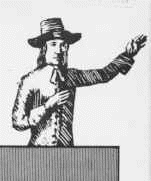|

|
Chapter 2: Early American Literature
1700-1800
John Woolman
1720-1772
|
© Paul P. Reuben
September 10, 2019
|
Page Links: |
Primary
Works |
Contributions
of John Woolman |
The
Inner Light |
The
Quaker Journal |
Selected
Bibliography 1980-Present
| Study
Questions |
MLA
Style Citation of this Web Page
|
Site Links: |
Chap
2 - Index |
Alphabetical
List |
Table
Of Contents |
Home
Page
|

Primary
Works
The works of John Woolman.
NY: Garrett Press, 1970. BX7617 .W6
The journal and major essays of John
Woolman. Ed. Phillips P. Moulton. NY: Oxford UP, 1971. BX7795.W7 A3
1971b
Journal. Ed. Thomas S. Kepler.
Cleveland: World Pub. Co. 1954. BX7795.W7 A3
The Journal of John Woolman and A
Plea for the Poor. Tolles, Frederick B. (ed.). NY: Corinth, 1961.
Contributions
of John Woolman (from Rosenblatt, Paul. John Woolman. NY:
Twayne, 1969.)
1. Sought to abolish slavery.
2. Tried to achieve a fair treatment of
Indians.
3. Tried to vitalize Quaker pacifism.
4. Tried to return Friends to the
experience of the Inner Light.
5. Tried to free people from material
cravings.
The
Inner Light of the Quakers is the belief that God is present
(immanent) in the human heart. This belief became the main doctrine
of the Quaker leader George Fox.
This is different from
Jonathan Edwards' Divine & Supernatural Light which was
made available by God to certain chosen people.
"The Edwardian divine light was a
supplementary sense added to man's natural sense by Divine Grace, as a
formulation of man's idea of divinity. The Quaker inner light was a
specific and direct guidance from God to prompt man to particular
actions in any situation, and therefore a foundation of man's
humanity." (Joseph Blau, Men & Movements in American Philosophy,
1952)
The
Quaker Journal
"I have often felt a motion of
Love to leave some hints of my experience of the Goodness of God." -
John Woolman
The Quaker journal, like
that of the Puritans, is a special form of autobiography. It records
God's presence in temporal events and phenomena. The Puritan journal,
however, was introspective and led to self examination (Am I saved?);
the Quaker one was written for publication. It had a strong social
emphasis in its concern with successful living.
The Form of the Quaker
Journal
- Divine revelations in childhood
- Compunction (regret, uneasiness) over
youthful frivolity
- Period of search and conflict
- Convincement
- Conversion
- Seasons of discouragement
- Entrance in the ministry
- Adoption of plain dress, plain speech,
and simple living
- Curtailment of business
- Advocacy of social reform
Few journals contain all
these stages, and many may contain only a few of them. Woolman's
autobiography is a classic record of all the stages.
- Jonathan Edwards offered mysticism and
heaven
- Ben Franklin offered a pattern of
utilitarian living
- John Woolman offered mystical insight
and compassionate humanism
Selected
Bibliography 1980-Present
Elliot, Emory. ed.
American Colonial Writers 1735-1781. Detroit: Gale,
1984.
Moment, Gairdner B., and
Otto F. Kraushaar. Utopias: The American Experience. Metuchen,
NJ: Scarecrow, 1980.
Study
Questions
1. Compare the specific
imagery of The Journal with that of Jonathan Edwards's Personal
Narrative, with the goal of demonstrating differences between
Woolman's religious beliefs and worldview and those of the
Puritans.
2. Compare and contrast
Woolman's Journal with Ashbridge's Some Account. What can we infer
about Quaker life in the colonies from these two writers? To what
extent are differences in their narratives attributable to
gender?
3. (a) Would Woolman feel
that his life and ministry made a difference to the world of today?
(b) How would he feel about today's world? About social injustice in
third world countries? About our response as individuals and as
Americans to poverty and social injustice in other lands?
MLA Style
Citation of this Web Page
Reuben, Paul P. "Chapter 2: John
Woolman." PAL: Perspectives in American Literature- A Research and
Reference Guide. URL: WWW
URL: http://www.paulreuben.website/pal/chap2/woolman.html (provide page date or date of your
login).
| Top |

